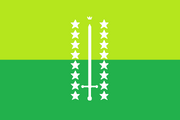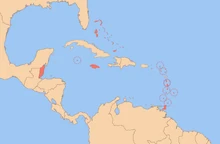(Noted government type in Infobox.) |
m (→East Caribbean Navy: Added sailor total to Second Task Force.) |
||
| Line 98: | Line 98: | ||
| − | The Second Task Force operates in the East Caribbean, based out of Compton Naval Base, St. Lucia. Its mission objective is to keep peace in East Caribbean waters and participate in S & R operations. The 2nd Task Force operates the most auxiliary ships of the three task forces, and is generally held in reserve, to be dispatched to the other two task forces if necessary. The 2nd Task Force consists of the following ships : |
+ | The Second Task Force operates in the East Caribbean, based out of Compton Naval Base, St. Lucia. Its mission objective is to keep peace in East Caribbean waters and participate in S & R operations. The 2nd Task Force operates the most auxiliary ships of the three task forces, and is generally held in reserve, to be dispatched to the other two task forces if necessary. The 2nd Task Force consists of 598 sailors and the following ships : |
*CNS Bridgetown : Snakehead-Class Patrol Ship. |
*CNS Bridgetown : Snakehead-Class Patrol Ship. |
||
*CNS San Juan : Snakehead-Class Patrol Ship. |
*CNS San Juan : Snakehead-Class Patrol Ship. |
||
Revision as of 21:41, 8 December 2013
| |||||||
| Capital | Castries | ||||||
| Largest city | Kingston | ||||||
| Other cities | Belize City | ||||||
| Language official |
English | ||||||
| others | several creole languages, Spanish, French | ||||||
| Legislature | Federal Parliamentary Monarchy | ||||||
| Population | appr. 5,750,000 | ||||||
| Independence | 1987 | ||||||
| Currency | East Caribbean dollar | ||||||
The East Caribbean Federation is a democratic federation of island states in the Caribbean Sea. It was formed on January 1st, 1987, four years after Doomsday. It primarily consists of former British colonies.
History
Prior to 1983, most member states of the East Caribbean Federation were small, independent nations or dependent territories of global powers, most prominently the United States of America and the United Kingdom. The economies of these islands were heavily dependent on tourism and the sugar trade.
The tourist trade and the sugar trade both collapsed in the wake of Doomsday. This devastated the Caribbean economic community, cutting the economies of most islands by half. South America was also experiencing political and economic crisis in the wake of Doomsday, and could offer little trade and no aid to the island nations.
Almost immediately the various islands reached out to one another, beginning with an agreement of mutual aid between St. Lucia and Barbados. The agreement soon expanded to include Trinidad and Tobago, as well as St. Vincent and the Grenadines. It evolved beyond mutual aid, culminating in a joint military operation to displace the military junta in Grenada. From there it progressed to talks of another union of some sort being established.
On January 1st, 1987, the East Caribbean Federation was officially formed, consisting of those four nations involved in the aid agreement. It took its flag and symbols from the former West Indies Federation, an attempt at Caribbean unification from 1958 to 1962 that had failed due to nationalist tensions between the islands. Since then, it has expanded into a federation of 16 semi-sovereign states.
Nationalist movements within the Federation, most prominently on the islands of Jamaica and Trinidad, have threatened the stability of the union from time to time, though regional governments have managed to keep this under control. As a result, the ECF has only become more unified over time. Most citizens, especially on the smaller islands, enjoy the prosperity and stability the federation provides, and have little desire to divide it once again. Tourism and trade have slowly, yet steadily, increased over the decades since Doomsday.
The young nation has also been active in exploring the former US state of Florida. They discovered a survivor nation on the southwest side of the former state called the Republic of South Florida.
Territories
The East Caribbean Federation is a federal union of 16 semi-sovereign states.
- St. Lucia (Founding Member, 1987)
- Barbados (Founding Member, 1987)
- St. Vincent and the Grenadines (Founding Member, 1987)
- Trinidad and Tobago (Founding Member, 1987)
- Belize
- Anguilla
- Antigua and Barbuda
- Bahamas
- Cayman Islands
- Dominica
- Jamaica
- Montserrat
- St. Kitts and Nevis
- Turks and Caicos Islands
- British Virgin Islands
- United States Atlantic Remnant (autonomous)
Cuba, the Dominican Republic, and Puerto Rico, much more self-sufficient and Spanish-speaking, opted to stay out of the federation. Haiti's economy was extremely weak to begin with, and eventually became so dependent on East Caribbean aid that it became little more than a puppet state for quite some time.
Potential New Territories
There have occasionally been calls within the English speaking islands of the Netherlands Antilles to join the federation.
Certain segments of the population have also called for Haiti to be included in the Federation as well.
Politics
The East Caribbean Federation is a Federated Commonwealth Realm, with a Prime Minister and a Governor-General. There are two main political parties in the ECF, these being the Conservative Party, which is a centre-right party, and the Liberal Party, which is a centre-left party. Minor parties include the Caribbean Communist Party (CCP) and the One Nation Party, which advocates annexing all the Caribbean Islands and instituting a constitutional monarchy at the federal level to replace the current republican system in place.
International Relations
The East Caribbean Federation has been wary of both the increasing importance of South America and the widespread socialist influence in Central America and the Caribbean Sea. Due to these worries the ECF has maintained strong ties with the main Anglophone power, the Commonwealth of Australia and New Zealand.
The ECF is a member of the League of Nations.
Economy
The East Caribbean Federation's primary trading partners are South America and the ANZC.
Military

The ECDF Flag.
The member states of the East Caribbean Federation do not possess individual armies. Instead, they are all serviced and protected by a single, unitary military, called the East Caribbean Defence Force (ECDF.) The ECDF itself contains several branches : The East Caribbean Navy (ECN) ; The East Caribbean Marine Corps (ECMC) ; the East Caribbean Field Army (ECFA) ; and the East Caribbean Air Force (ECAF.)
Originally, the mainstay of the military was provided by the Jamaican Defence Force, the British contingent in Belize and remnants of American Armed Forces who did not join the USAR. In contemporary times, the ECDF equipment is mostly purchased from the SAC. However the United States Atlantic Remnant continues to operate remnants of the US Navy, Army and Air Force as an independent military.
The East Caribbean Navy is the primary military force of the ECF, due to the federation being an overwhelmingly maritime nation. The ECN is primarily geared towards Search and Rescue and anti-piracy operations, though in recent years, as the nation's regional power grows, it has begun to diversify its offensive portfolio. In total, the ECN operates two corvettes, 14 patrol ships, six fast attack boats, and four auxiliary ships. The ECN operates three primary missions, to which the bulk of its naval forces are devoted.
The First Task Force operates in the North Caribbean, based out of Port Antonio, Jamaica. Its mission objective is to keep peace in North Caribbean waters and participate in S & R operations. It is the most offensive of the three task forces. It is intended to act as a strategic deterrent to potential Cuban and Dominican aggression. It is also intended to be dispatched to Belize in the event of an outbreak of hostilities with Guatemala, in order to ensure complete naval control of the region. The First Task force consists of the following ships :
- CNS Aegis : Lionfish-Class Corvette.
- CNS Tim Hector : Snakehead-Class Patrol Ship.
- CNS Baldwin : Snakehead-Class Patrol Ship.
- CNS Oversight : Snakehead-Class Patrol Ship.
- CNS Hayes : Snakehead-Class Patrol Ship.
- CNS Watchman : Snakehead-Class Patrol Ship.
- CNS Seraphin : Snakehead-Class Patrol Ship.
- CNS William Shorey : Grouper-Class Fast Attack Boat.
- CNS Anguilla : Grouper-Class Fast Attack Boat.
The Second Task Force operates in the East Caribbean, based out of Compton Naval Base, St. Lucia. Its mission objective is to keep peace in East Caribbean waters and participate in S & R operations. The 2nd Task Force operates the most auxiliary ships of the three task forces, and is generally held in reserve, to be dispatched to the other two task forces if necessary. The 2nd Task Force consists of 598 sailors and the following ships :
- CNS Bridgetown : Snakehead-Class Patrol Ship.
- CNS San Juan : Snakehead-Class Patrol Ship.
- CNS Cockburn : Snakehead-Class Patrol Ship.
- CNS Great Abaco : Snakehead-Class Patrol Ship.
- CNS Lee Moore : Clownfish-Class Support Ship (Tugboat Outfit.)
- CNS : Clownfish-Class Support Ship (Buoy Tender Outfit.)
- CNS : Clownfish-Class Support Ship (Training Ship Outfit.)
- CNS : Palm-Class Support Ship (Replenishment Oiler Outfit.)
The Third Task Forces operates in the West Caribbean, based out of Punta Gorda, Belize. Its mission objective is to keep peace in West Caribbean Waters and participate in S & R operations. The 3rd Task Force is a smaller force, and is intended to act as a deterrent to Guatemalan aggression. The 3rd Task Force consists of the following ships :
- CNS Guardian : Lionfish-Class Corvette.
- CNS Gros Islet : Snakehead-Class Patrol Ship.
- CNS Cayo : Snakehead-Class Patrol Ship.
- CNS Chris Blackwell : Snakehead-Class Patrol Ship.
- CNS John Compton : Snakehead-Class Patrol Ship.
- CNS Milton Cato : Grouper-Class Fast Attack Boat.
- CNS Mutabaruka : Grouper-Class Fast Attack Boat.
- CNS Orange Walk : Grouper-Class Fast Attack Boat.
- CNS Cayman : Grouper-Class Fast Attack Boat.
See also
| |||||||||||



